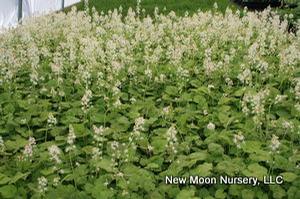Printed at http://www.newmoonnursery.com/index.cfm/
Tiarella cordifolia wherryi
Foam flower
Native to North America
FIRST IMPRESSIONS: Tiarella wherryi is a low mounding or clumping wildflower with heart shaped lobed leaves. The blades are adorned with reddish or purplish veins. In spring, foliage is crowned by spikey racemes of starry white florets. Foamflower is a fine groundcover for woodlands or shade gardens with moist well drained soil.
HABITAT & HARDINESS: This species occurs in eastern North America from Maryland to Kentucky and south to Georgia, Alabama and Mississippi mainly in the piedmont and mountain regions.
Tiarella wherryi is indigenous to rich mesic woodlands, moist acidic forests and moist granite outcrops.
Plants are hardy from USDA Zones 5-7.
PLANT DESCRIPTION: Tiarella wherryi is a clumper that increase in girth from underground rhizomes. This species does not initiate runners and form colonies as other Tiarella spp. are wont to do.
The leaves can be deciduous or semi-evergreen. They are pale green with maroon highlights and long petioles that originate from the rhizome. They are 4” across with 3-5 toothed maple-like lobes.
Foliage has red or purple veins and scattered glandular hairs. Blades can take on a purplish tint in autumn and winter.
In spring airy flower racemes rise from the foliage to a height of 10” or so. The racemes contain small white starry florets that emerge from deep pink buds. Each floret has long stamens that impart a foamy or feathery appearance.
The fruit is a small lopsided capsule that splits into two segments full of shiny black seed.
Plants grow 10” tall with an equal spread.
CULTURAL & MAINTENANCE NEEDS: Tiarella wherryi flourishes in acidic shady sites with average or moist well drained soil. Plants tolerate clay, loam, humidity, heat and some drought.
Plants are fairly pest resistant but need appropriate spacing and good air circulation to prevent problems. Foliage is occasionally nibbled by deer and rabbits.
This species grows best in soils that are rich and moisture retentive but cannot tolerate sites that are wet or soggy in winter.
LANDSCAPE USES: This is a good Groundcover for a Wildlife Garden or Shade Garden. Plants are also used as Butterfly Nectar Plants or as part of a Grouping or Mass Planting. In mild climates attractive rosettes provide Winter Interest. Tiarella wherryi has Showy Blooms and is appropriate for Cottage Gardens, Rock Gardens, Low Maintenance Plantings and Perennial Borders.
COMPANION & UNDERSTUDY PLANTS: Try pairing Tiarella wherryi with Adiantum pedatum, Athyrium filix-femina, Carex albicans, Heuchera americana 'Dales Strain', Iris cristata, Phlox stolonifera or Polystichum acrostichoides.
Tiarella cordifolia has similar appearance and culture and could be substituted in some situations.
TRIVIA: It is reported that early season bees, pollinating flies, moths and butterflies visit the flowers.
The generic name is from the Greek tiara which refers to the shape of the seed capsule which resembles a turban once worn by Persian noblemen. The specific epithet wherryi honors Dr. Edgar T. Wherry (1885 – 1982), the botanist who discovered the species.
This member of the Saxifrage Family is also known as Tiarella cordifolia var. collina.
The species is very similar in appearance to Tiarella cordifolia but has a more southern distribution and is more tolerant of heat and humidity. It is also a clumper while T. cordifolia is stoloniferous.
Tiarella wherryi received the Royal Horticultural Society’s Award of Garden Merit in 1993.
Height:
10 InchesSpread:
10 inSpacing:
20-24 inUSDA Hardiness Zone:
5-7Bloom Color:
WhiteTiarella cordifolia wherryi Characteristics
Attracts Wildlife
- Pollinators
- Butterflies
Attributes
- East-Coast Native
- Drought Tolerant
- Clay Soil
- Bog
- Naturalizing
- Ground Cover
- Interesting Foliage
Exposure
- Full Shade to Partial Shade
Flowering Months
- May
- April
Foliage Color
- Green
Growth Rate
- Medium
Season of Interest (Foliage)
- Fall
- Summer
- Spring
Soil Moisture Preference
- Moist

